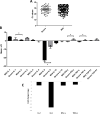Analysis of differential gene expression of pro-inflammatory cytokines in the nasopharyngeal milieu of mild & severe COVID-19 cases
- PMID: 36584119
- PMCID: PMC9803207
- DOI: 10.1371/journal.pone.0279270
Analysis of differential gene expression of pro-inflammatory cytokines in the nasopharyngeal milieu of mild & severe COVID-19 cases
Abstract
Introduction: A subset of individuals with COVID-19 can suffer from a severe form of the disease requiring breathing support for respiratory failure and even death due to disease complications. COVID-19 disease severity can be attributed to numerous factors, where several studies have associated changes in the expression of serum pro-inflammatory cytokines with disease severity. However, very few studies have associated the changes in expression of pro-inflammatory changes in the nasopharyngeal milieu with disease severity. Therefore, in the current study, we performed differential gene expression analysis of various pro-inflammatory cytokines in the nasopharyngeal milieu of mild & severe COVID-19 cases.
Material and method: For this retrospective, cross-sectional study, a total of 118 nasopharyngeal swab samples, previously collected from mild and severe (based on the WHO criteria) COVID-19 patients were used. A real-time qPCR was performed to determine the viral loads and also evaluate the mRNA expression of eight cytokines (IL-1, IL-2, IL-4, IL-6, IL-10, IFN-γ, TGF-β1, and TNF-α). Subsequently, an unpaired T-test was applied to compare the statistical difference in mean expression of viral loads and each cytokine between the mild and severe groups, while the Pearson correlation test was applied to establish a correlation between disease severity, viral load, and cytokines expression. Similarly, a multivariable logistic regression analysis was performed to assess the relationship between different variables from the data and disease severity.
Results: Out of 118 samples, 71 were mild, while 47 were severe. The mean viral load between the mild and severe groups was comparable (mild group: 27.07± 5.22; severe group: 26.37 ±7.89). The mRNA expression of cytokines IL-2, IL-6, IFN- γ, and TNF-α was significantly different in the two groups (p<0.05), where the Log2 normalized expression of IL-2, IL-6, IFN- γ, and TNF-α was found to be 2.2-, 16-, 2.3-, and 1.73-fold less in the severe group as compared to the mild group. Furthermore, we also observed a significant positive correlation between all the cytokines in the severe group. The multivariate analysis showed a significant relationship between age, IL-6, and disease severity.
Conclusion: This decreased expression of certain cytokines (IL-2, IL-6, TNF-α, and IFN-γ) in the nasopharyngeal milieu may be considered early biomarkers for disease severity in COVID-19 patients.
Copyright: © 2022 Ghulam et al. This is an open access article distributed under the terms of the Creative Commons Attribution License, which permits unrestricted use, distribution, and reproduction in any medium, provided the original author and source are credited.
Conflict of interest statement
The authors have declared that no competing interests exist.
Figures

Similar articles
-
Epithelial Antimicrobial Peptide/Protein and Cytokine Expression Profiles Obtained from Nasopharyngeal Swabs of SARS-CoV-2-Infected and Non-Infected Subjects.Viruses. 2024 Sep 15;16(9):1471. doi: 10.3390/v16091471. Viruses. 2024. PMID: 39339947 Free PMC article.
-
Analysis of differential expression of matrix metalloproteinases and defensins in the nasopharyngeal milieu of mild and severe COVID-19 cases.PLoS One. 2025 Feb 18;20(2):e0304311. doi: 10.1371/journal.pone.0304311. eCollection 2025. PLoS One. 2025. PMID: 39965032 Free PMC article.
-
High nasopharyngeal and serum IL-6 levels and the - 573G > C polymorphism (rs1800796) are linked with the risk of severe COVID-19 in a Mexican population: a case‒control study.BMC Infect Dis. 2025 Mar 5;25(1):315. doi: 10.1186/s12879-025-10695-y. BMC Infect Dis. 2025. PMID: 40045221 Free PMC article.
-
Gene expression of cytokines (TNF-α, IFN-γ), serum profiles of IL-17 and IL-23 in paediatric systemic lupus erythematosus.Lupus. 2012 Sep;21(10):1105-12. doi: 10.1177/0961203312451200. Epub 2012 Jun 29. Lupus. 2012. PMID: 22759859
-
Circulating Levels of Interleukin-6 and Interleukin-10, But Not Tumor Necrosis Factor-Alpha, as Potential Biomarkers of Severity and Mortality for COVID-19: Systematic Review with Meta-analysis.J Clin Immunol. 2021 Jan;41(1):11-22. doi: 10.1007/s10875-020-00899-z. Epub 2020 Oct 31. J Clin Immunol. 2021. PMID: 33128665 Free PMC article.
Cited by
-
Association of Interferon Lambda 3 and 4 Gene SNPs and Their Expression with COVID-19 Disease Severity: A Cross-Sectional Study.Infect Drug Resist. 2023 Oct 10;16:6619-6628. doi: 10.2147/IDR.S422095. eCollection 2023. Infect Drug Resist. 2023. PMID: 37840831 Free PMC article.
-
Epithelial Antimicrobial Peptide/Protein and Cytokine Expression Profiles Obtained from Nasopharyngeal Swabs of SARS-CoV-2-Infected and Non-Infected Subjects.Viruses. 2024 Sep 15;16(9):1471. doi: 10.3390/v16091471. Viruses. 2024. PMID: 39339947 Free PMC article.
-
Enhanced impact resistance of novel sustainable preplaced aggregate geopolymer concrete reinforced with steel mesh and 5D fibers.Sci Rep. 2025 Aug 12;15(1):29564. doi: 10.1038/s41598-025-14281-9. Sci Rep. 2025. PMID: 40796627 Free PMC article.
-
Analysis of differential expression of matrix metalloproteinases and defensins in the nasopharyngeal milieu of mild and severe COVID-19 cases.PLoS One. 2025 Feb 18;20(2):e0304311. doi: 10.1371/journal.pone.0304311. eCollection 2025. PLoS One. 2025. PMID: 39965032 Free PMC article.
References
Publication types
MeSH terms
Substances
LinkOut - more resources
Full Text Sources
Medical

